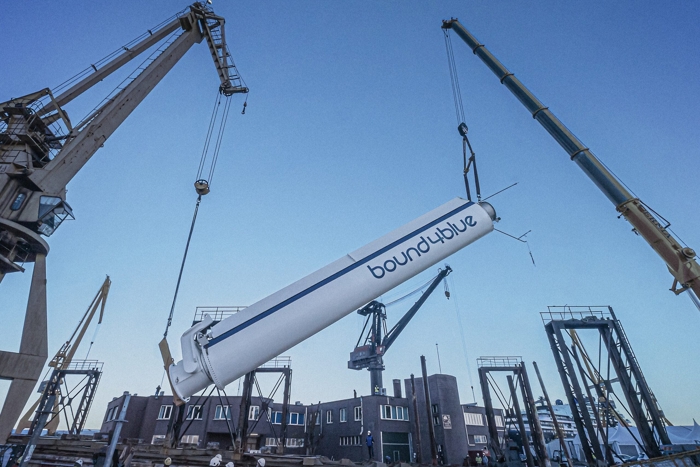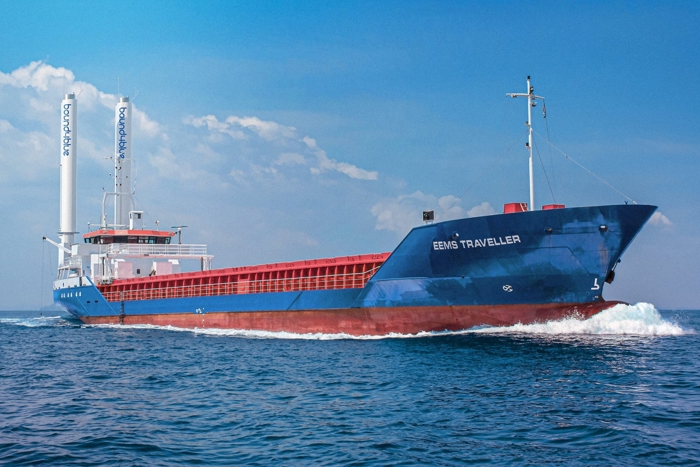It's been a hot and hectic summer for executives at wind sail company, bound4blue. In August, the wind sail developer completed its latest funding round, raising more than EUR 20 million, and announced the first installation of its suction sail technology in the tanker sector, a chemical tanker belonging to Bergen-based Odfjell. Although not finally confirmed, the 2024 suction sail installation will be aboard a vessel in the Hudong 49k series, and could be the first of many.
Speaking about the successful capital raising exercise, company co-founder Cristina Aleixendri Muñoz tells Horizons that up until now, bound4blue has been funded by private (60%) and institutional (40%) investors. These include EIT Climate-KIC, a European Institute of Innovation and Technology-supported setup that supports climate-related initiatives, the Spanish Government and several private investors in the maritime sector.
“Early in September, we announced the successful closure of a capital increase round, securing more than EUR 20 million to fuel our growth and expansion,” Muñoz reveals. “Several industry-leading companies, including GTT and Louis Dreyfus Company, amongst others, have joined as investors alongside the European Commission in this investment round.”
Setting the scene, co-founder David Ferrer points out that shipowners face major challenges in adapting existing ships to improve carbon performance in terms of CII ratings; in absorbing dramatic increases in fuel prices as a new generation of marine fuels arrives; and in complying with a tightening regulatory framework, most notably in Europe where regulations, such as FuelEU, have far-reaching implications on ship operation. Wind power, he says, makes eminently good sense for many types of commercial ships.
What's the appeal?
There are four main types of sails suitable for commercial ship applications – kites, wing sails, Flettner rotors, and suction sails. The last of these is the focus for bound4blue’s business and Ferrer explains its principles.
In a normal wing sail, air flow detaches when the angle of attack reaches a certain point. By sucking in a small amount of air, however, the flow around a suction sail can be re-attached, boosting the lift coefficient by a factor of six or seven, up from around 1.2 to about 8.2. This means a six-to-seven times gain in efficiency, enabling far higher savings or a better outcome from a smaller sail, Ferrer says.
There are many advantages. Capital costs are lower, installations are easier and cheaper, and payback times are shorter. Furthermore, unlike similarly shaped Flettner rotors, suction sails are driven by the wind and do not need significant shipboard power to keep spinning.


Results so far
Four years ago, the company’s directors decided that pilot projects were required on suitable ships so that proof of superior suction sail performance could be demonstrated in practice. Lloyd’s Register will be involved in verifying some of the results.
The first three installations are a 12-metre sail on a longliner fishing vessel, Balueiro II; a 17-metre sail on theatre vessel, La Naumon, operated by La Fura dels Baus and Elipsis Onboard; and two 17-metre sails on the general cargo ship, Eems Traveller, owned by Amasus Shipping of the Netherlands.
Other projects on the company’s books include three 22-metre sails to be installed on the Ville de Bordeaux roro vessel owned by Louis Dreyfus Armateurs; four 26-metre sails on the Marubeni-owned panamax bulk carrier, Crimson Kingdom; and the recently booked Odfjell chemical tanker. Although the ship is not finally confirmed, the installation is scheduled for 2024. It could be the first of many across the company’s 50-odd owned and bareboat chartered fleet.
Odfjell’s technical personnel have been assessing wind-assisted propulsion systems (WAPS) and their relative benefits for about three years. Its decision to work with bound4blue followed a major study by Sweden’s SSPA Maritime Center, a performance data analyst and member of the International Windship Association. The SSPA identified the Spanish company’s suction sail technology as the most suitable for retrofits on board Odfjell tankers in the future.
Where the wind blows
The benefits of wind sails vary widely, both between ship types, and depending on trading patterns. Ferrer explains that tankers, bulk carriers, ferries, roro’s, and LNG carriers all stand to benefit. Installing sails on an existing container would probably be uneconomic owing to loss of cargo slots, but future boxship designs could make space for sails. Ships that spend significant periods on standby (OSVs, for example), or operate slowly (cable layers) are not suitable.
Likely trading patterns are important, too. That is why bound4blue offers a free ‘preliminary case analysis’. The company needs quick details of a ship and its likely trade, and using heat maps of the world’s wind patterns, can provide an analysis of the approximate benefits a suction sail installation might yield.
Wind patterns in the major oceans are well-known. The north and south regions of both the Atlantic and Pacific oceans, and the Indian Ocean are all broadly favourable. But more local winds may prove a challenge. Some of the wind patterns around Greece and its islands, for example, could be tricky as could a vessel trading north to south in the Baltic Sea.
Ace card
Muñoz and Ferrer like to hold their unique selling point until last. They will not manufacture their own sails but, expecting a surge in demand, they have focused on the development of their global supply chain. They are therefore partnering with wind turbine manufacturers in various parts of the world.
“Our sails are very similar to wind turbines – a tube with two flanges and elements fixed inside,” Muñoz explains, “and wind turbine manufacturers are usually on the coast. We are already working with Haizea Wind Group in Bilbao and our tie-up with Marubeni, as a sales agent, may help in arranging an Asian partner.”
The development of a global network will provide a key selling point by offering shipowners flexibility. Preparations, including the installation of foundations for sails, could be made at a routine docking, for example, in preparation for subsequent installation at a manufacturer’s plant.








